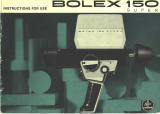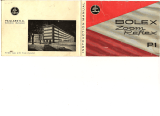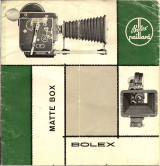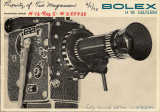BOLEX ELECTRIC H
BOLEX ELECTRIC H is a camera hand grip used with H16 and H8 flat-base cameras equipped with an electric motor. It can be attached and removed in seconds, thanks to its quick-release mechanism: an intermediate piece, screwed under the camera, locks onto the handle using a lever. The handle is equipped with a built-in switch actuated by the trigger and connected to the electric motor by a cord. The correct setting once achieved, lock the flexible cable by tightening the screw (k). If you have a Vario-Switar, you can also work with the camera's spring motor while operating the preselection device from the handle, using the flexible cable:
BOLEX ELECTRIC H
BOLEX ELECTRIC H is a camera hand grip used with H16 and H8 flat-base cameras equipped with an electric motor. It can be attached and removed in seconds, thanks to its quick-release mechanism: an intermediate piece, screwed under the camera, locks onto the handle using a lever. The handle is equipped with a built-in switch actuated by the trigger and connected to the electric motor by a cord. The correct setting once achieved, lock the flexible cable by tightening the screw (k). If you have a Vario-Switar, you can also work with the camera's spring motor while operating the preselection device from the handle, using the flexible cable:








-
 1
1
-
 2
2
-
 3
3
-
 4
4
-
 5
5
-
 6
6
-
 7
7
-
 8
8
-
 9
9
-
 10
10
-
 11
11
-
 12
12
-
 13
13
-
 14
14
BOLEX ELECTRIC H
BOLEX ELECTRIC H is a camera hand grip used with H16 and H8 flat-base cameras equipped with an electric motor. It can be attached and removed in seconds, thanks to its quick-release mechanism: an intermediate piece, screwed under the camera, locks onto the handle using a lever. The handle is equipped with a built-in switch actuated by the trigger and connected to the electric motor by a cord. The correct setting once achieved, lock the flexible cable by tightening the screw (k). If you have a Vario-Switar, you can also work with the camera's spring motor while operating the preselection device from the handle, using the flexible cable:
Ask a question and I''ll find the answer in the document
Finding information in a document is now easier with AI
in other languages
- italiano: BOLEX ELECTRIC H Manuale del proprietario
- français: BOLEX ELECTRIC H Le manuel du propriétaire
- español: BOLEX ELECTRIC H El manual del propietario
- Deutsch: BOLEX ELECTRIC H Bedienungsanleitung
Related papers
Other documents
-
 Bolex Paillard 150 Super User manual
Bolex Paillard 150 Super User manual
-
 Bolex Paillard 7.5 MacroZoom User guide
Bolex Paillard 7.5 MacroZoom User guide
-
 Bolex Paillard C8 User manual
Bolex Paillard C8 User manual
-
Cateye HL-EL200 User manual
-
 Bolex Paillard 680 MacroZoom User manual
Bolex Paillard 680 MacroZoom User manual
-
 Bolex Paillard H16 EBM Electric User manual
Bolex Paillard H16 EBM Electric User manual
-
Bolex Paillard H16 EL User manual
-
Bauer T18 ML sound Owner's manual
-
Bauer T190 ML sound Owner's manual
-
Bauer T50 Sound Owner's manual





















